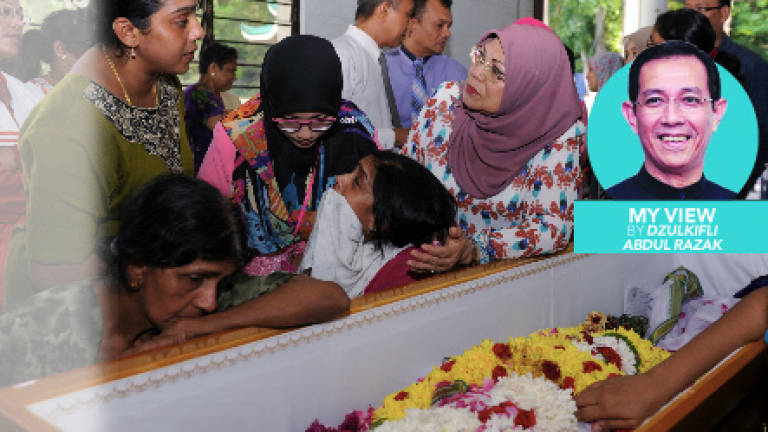Keeping our teenagers safe

IT was only last month that I wrote about the tragic death of a teenager, Thaqif, due to abuse in school. I never thought that I would feel compelled to write another piece on another teenager who was a victim of another abuse.
T. Nhaveen, a bright-looking lad of 18 years, who was brutally beaten up and sexually abused by a group of young thugs, died last week after lying “brain dead” for several days in Penang Hospital. He did not recover from his coma to tell what actually took place. That story will remain with him and we will be left guessing; although apparently this was not the first time he had been bullied and harassed.
As expected many expressed their sadness, anger and outrage after the fact, though this may not make much difference to the deceased and his loved ones. I do not mean this in an “unappreciative” way but more to express the “unhappiness” that not enough has been done to safeguard our teenagers especially those of the schoolgoing age. Namely on matters of personal security and safety in a broader sense.
If Thaqif’s case tells us that the school environment can lead to life-threatening abuses, Nhaveen’s case reminds us that it can be equally deadly outside school. In fact, taking into account the UPNM tragedy where a naval cadet died a few weeks earlier from torture wounds, it gives an impression that these are not isolated incidents.
They are more than the tip of the iceberg that has not been given the utmost level of urgency that they deserve. Let me give an analogy: almost every day issues of security and safety are bandied around in the media with a focus on “terrorism” (read: violence). Malaysia seems to be an active participant in this, regionally if not globally. Its involvement ranges from taking part in joint military exercises to the setting up of an international peace centre sponsored by another nation. All this sounds well and good to give a sense of urgency in the effort to bolster security and safety. Hundreds of millions are being spent on this, indeed, reportedly billions have been earmarked for the peace centre. It is money to be well-spent assuming that the partnership is well-brokered and the “enemies” are well-defined. These two points are crucial because to most people “peace” is a mere absence of war and violence although the “enemies” are still lurking around clandestinely. At times (more frequently nowadays) we are our own “enemies” in various ways for not walking the talk!
Here is where the case of Nhaveen and the like come to the fore. First, what level of security and safety are they provided? Are these the highest of standards that money can buy? For that matter how much money is available to make this the best there is? Second, what sort of training and awareness are teachers and other staff being exposed to? Are these compatible with our ways and lifestyles? It is not just to safeguard the school environment and atmosphere but also to live it in creating a peaceful milieu for effective learning? Third, how much of knowledge is imparted on “how to live together” as part of learning to nurture peace in practical and impactful ways? In other words, being streetwise and able to cope with “aggression” as part of living skills?
There are many more of course, but these are enough to indicate if we are our own “enemies” or otherwise! If we are indeed our own “enemies” then we can expect more violent deaths; even more frequent and brutal attacks which seems to be the trend because we have not cared enough. Soon the time will come when it is translated into a local brand of “terrorism” across the land. This is when the three basic Rs of reading, writing and arithmetic are rendered to producing rogues, ruffians and rascals as the human capital, thanks to the widespread and hidden abuses.
And the very moment they get access to another set of 3Rs – revolvers, repeaters and rifles, we will then have a full-blown home-grown problem to deal with like in the US where schools become “shooting galleries” every so often. Meaning that the millions spent to spruce up national security and safety will eventually come to nought, undermined by the latent “enemies” within. With the high level of corruption as exposed by MACC, the situation can easily swing out of control.
Given this possibility, we must contemplate on the deep-seated message and warning that the recent tragedies are impressing upon us. As the situation in fighting “terrorism” gets more dire, it can no longer be strategised in isolation or be compartmentalised from other forms of “violence” (including bullying), thinking that they are decoupled. This is simply not the case any more as we have learnt how youngsters get “radicalised”.
In short, long before we can create and sustain an international peace agenda, we must first secure internal (homeland) peace collectively. This in turn depends on the state of inner peace in each individual which lies at the very heart of the education process. In this sense, Nhaveen and Thaqif remain epitomes of how much more must be done before questions like that allegedly posed by Nhaveen’s mother (“Will he be the last to die like this?”) could ever be convincingly answered. Only then will “real” justice be seen to be done.
While remaining hopeful, with a deep sense of accountability and sadness, we bid goodbye to beloved Nhaveen. May you rest in peace.
With some four decades of experience in education, the writer believes that “another world is possible”. Comments: letters@thesundaily.com